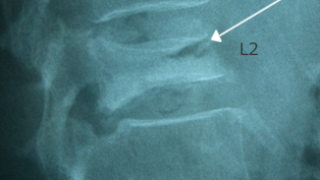Osteoporotic Vertebral Compression Fracture
09/05/2022
最終更新日時 :
03/10/2024
 webmaster
webmaster
We will provide information on the surgical methods, length of hospital stay, and insurance coverage for osteoporotic vertebral compression fractures.
What is Osteoporotic Vertebral Compression Fracture?
Osteoporotic Vertebral Compression Fracture
Osteoporosis is a condition where the balance between bone resorption and formation is disrupted, leading to decreased bone mass and weakened bones. With osteoporosis, not only do bones become porous, but their quality also deteriorates, making them more fragile. Bone balance is influenced by female hormones, so osteoporosis is commonly observed in women after menopause. The fractures that occur in the weakened spine due to osteoporosis are called compression fractures.

Symptoms
As osteoporosis progresses, compression fractures can occur even without trauma or falls. When a fracture happens, it causes severe pain in the back and waist. The collapsed vertebra does not return to its original shape, so the bones heal in the collapsed state, leading to a reduction in pain. However, after the pain subsides, conditions such as a rounded back (kyphosis or hunchback) and reduced height may remain. Once a fracture occurs, the risk of subsequent fractures increases, making both the initial treatment of fractures and the prevention of osteoporosis crucial.
Treatment methods
Bones can be relatively easily measured, so if a decrease in bone density is observed, medications that increase bone density or strengthen bones may be prescribed. If a compression fracture has already occurred, braces or casts may be used to relieve pain and prevent spinal deformities. If appropriate treatment is not provided, the bones may fail to heal properly, and pain may persist.
Surgical methods
This healing involves expanding the cavity within the collapsed vertebra using a balloon and injecting bone cement into it (Balloon Kyphoplasty, BKP). Additionally, sometimes the instability or deformity of the fractured bone can compress nerves, leading to lower limb paralysis. Decompression and stabilization surgery may be required, so early consultation is recommended.

- Disease Name
- Osteoporotic Vertebral Compression Fracture
- Body Part
- Back and Chest、Lower Back and Buttocks
- Type of Disease
- Bone Weakening